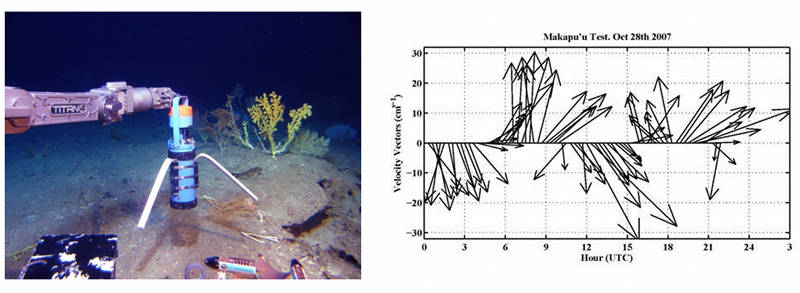
By Frank A. Parrish - Expedition Co-Science Lead
August 28, 2015
The patchy nature of deep-sea corals makes them hard to find and difficult to study. We know they settle and grow in current-swept hard-bottom areas. As suspension feeders, corals eat the organic material that passes by in the water column. For that reason corals grow on underwater ridges, along ledges, and in other areas where bottom flow is constrained and moves more rapidly, delivering food at a higher rate.
In an attempt to understand the flow rate in coral beds, various seafloor instruments were deployed in the main Hawaiian Islands by submersibles in prior years and will be recovered during Leg 3 of the 2015 Hohonu Moana expedition by NOAA Ship Okeanos Explorer.

Figure 1. Photo: Acoustic current meter with particulate sensor and thermograph. Graph: A vector plot of the direction and flow intensity of the passing water over 24 hours. Image courtesy of the Hawaii Undersea Research Lab. Download larger version (jpg, 333 KB).
Areas with a high density of corals are often found growing at a depth and on substrate that is similar to an adjacent area without corals and the reason for this is not known. The boundaries we see may just be the edge of growth for the coral patch at that point in time, or it could be some limitation in the suitability of the environment for corals to settle and grow (temperature, water flow, particulate load, etc.). Placing instruments to collect data both in and adjacent to coral beds provides a means to compare environmental factors that might influence the settlement and growth of coral patches.
Dives at three study sites during Leg 3 (South Oahu; Makapuu Point, Oahu; and Keahole Point, Big Island of Hawaii) will be focused on recovering two types of instruments: An acoustic current meter (Figure 1) that provides current direction, flow rate, and an optic sensor for particle load and a number of simpler flow meters (Figure 2) that monitor the speed of the passing water.
The primary challenge of the dives will be to relocate the instruments for collection and the level of success will likely depend on the intensity of the current the pilots encounter. Previous experience has shown these sites can experience high current, particularly associated with the extremes in the tidal cycle. Once the pilots are finished working with the instruments, the rest of the dives will be spent exploring the sites and making observations on animals and the geology as they are encountered.

Figure 2. Photo: Flow meter with thermograph. Graph: Counts of impellor rotations showing tidal fluctuations in passing water flow over three months. Image courtesy of the Hawaii Undersea Research Lab. Download larger version (jpg, 364 KB).